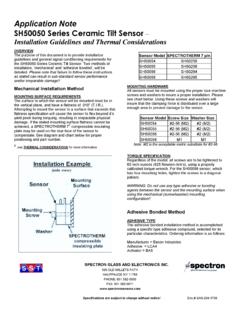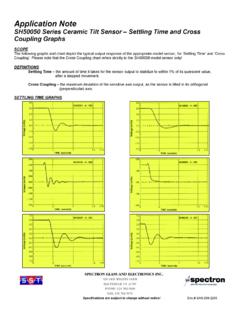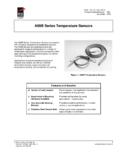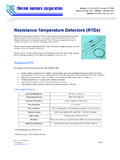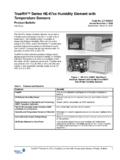Transcription of Application Note - Spectron
1 Application Note Temperature compensation resistor Selection Procedure MUPI-3, SSY0079 and SA40012 Signal Conditioners Spectron SYSTEMS TECHNOLOGY INC. 595 OLD W ILLETS PATH HAUPPAUGE NY 11788 PHONE: 631 582-5600 FAX: 631 582-5671 Specifications are subject to change without notice! Doc.# SAN-216-3508 This Application Note provides procedural guidelines for selecting a proper value temperature compensation resistor , for the MUPI-3, SSY0079 and SA40012 Signal Conditioners. This resistor is employed to reduce the level of scale temperature coefficient effects. It is important to note that it will have no influence on the null (zero) temperature coefficient , which is generally minimal. The temperature compensation resistor , identified as either RT, R1 or R3, is used in conjunction with a #KTY81-120 silicon temperature sensor.
2 Each signal conditioner has a position and/or connection point for both items. Please see the specific Product Data Sheet for the Signal Conditioner you are using. It is important to note that this procedure is strictly a guideline. Due to the various nuances of each sensor type, and their associated relationship between the signal conditioner and compensation components, no firm rule can be applied to determine the exact value. Therefore, some experimentation will be required to optimize results. Procedure Note: This procedure assumes that the test equipment used is of adequate accuracy and repeatability. Assure prior to proceeding that all test equipment specifications are acceptable! 1. If the #KTY81-120 silicon temperature sensor has not already been connected to the signal conditioner, do so at this time.
3 2. Connect a decade resistance box across the RT, R1 or R3 position (model dependent) of the signal conditioner. 3. Obtain the nominal starting for value for RT, R1 or R3 from the chart below, and adjust decade resistance box to that value. Note that the SH50058-A-003 requires no resistor to be installed. All values are in ohms. Signal Conditioner Model Signal Conditioner Model Sensor Type MUPI-3 SSY0079 SA40012 Sensor Type MUPI-3 SSY0079 SA40012 RG-33A 70K 140K 140K SH50054-A-00370k 140K 140K RG-33T 70K 140K 140K SH50055-A-00970k 140K 140K RG-33N 70K 140K 140K SH50056-A-00310K 75k 75k RG-57S 70K 65K 65K SH50056-A-00810K 75K 75K CG-10N 10K 65K 65K SH50058-A-001 100K 100K 100K CG-50S 10K 65K 65K SH50058-A-003 open
4 Open open CG-57S 10K 65K 65K L-210 30k 100K 100K L-211U 20K 75K 75K L-212T 20k 75K 75K 4. Apply power to the signal conditioner, and let output stabilize. Application Note Temperature compensation resistor Selection Procedure MUPI-3, SSY0079 and SA40012 Signal Conditioners Spectron SYSTEMS TECHNOLOGY INC. 595 OLD W ILLETS PATH HAUPPAUGE NY 11788 PHONE: 631 582-5600 FAX: 631 582-5671 Specifications are subject to change without notice!
5 Doc.# SAN-216-3508 5. Check the output of the signal conditioner at null (zero) and at full scale by tilting the sensor through its full angular range. Adjust null and scale if necessary to achieve desired values. See the Product Data Sheet for the Signal Conditioner you are using for details on adjustments. 6. Record output readings at null and full scale, and ambient (room) temperature in oC (degrees Celsius). 7. Reduce temperature chamber setting to lowest operating temperature desired (within specification limits), and let soak for one hour. 8. Record output readings at null and full scale, and actual test temperature. 9. Increase temperature chamber setting to highest operating temperature desired (within specification limits), and let soak for one hour.
6 10. Record output readings at null and full scale, and actual test temperature. Return temperature chamber to room temperature. 11. Calculate the scale factor for the three temperature readings recorded, by subtracting the null reading from the full scale reading at each temperature. 12. Compare the high temperature scale factor to the low temperature scale factor. If it is of a higher value, then the temperature coefficient is considered to be positive . If it is lower, it is negative . NOTE: Only coefficients of a negative value can be compensated. If your testing has yielded a positive value, please consult factory! 13. Subtract the lower of the two from the higher. Divide this number by the scale factor at ambient (room) temperature, times by 100, and divide by the temperature test range (highest minus lowest temperature).
7 This will give you the scale temperature coefficient in % / oC . See equation below. Highest scale factor lowest scale factor X 100 temp. test range (oC) = % / oC Scale Factor at ambient temperature 14. The approximate change to the value of RT / R1 is determined as follows. For every of scale temperature coefficient, increase the value RT / R1 by a factor of For example, if the starting value of RT / R1 was 10K ohms, and the scale temperature coefficient was , the new value would be 45K ohms. 15. Adjust decade resistance box to this new value. 16. Repeat step #5 through #14 until desired results are obtained.






